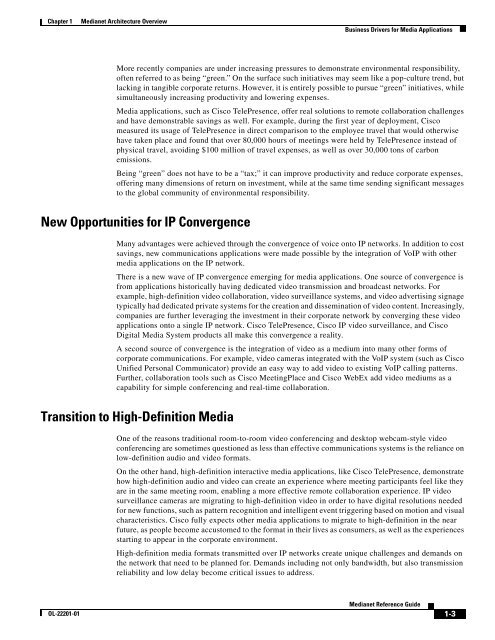Medianet Reference Guide - Cisco
Medianet Reference Guide - Cisco
Medianet Reference Guide - Cisco
Create successful ePaper yourself
Turn your PDF publications into a flip-book with our unique Google optimized e-Paper software.
Chapter 1<br />
<strong>Medianet</strong> Architecture Overview<br />
Business Drivers for Media Applications<br />
More recently companies are under increasing pressures to demonstrate environmental responsibility,<br />
often referred to as being “green.” On the surface such initiatives may seem like a pop-culture trend, but<br />
lacking in tangible corporate returns. However, it is entirely possible to pursue “green” initiatives, while<br />
simultaneously increasing productivity and lowering expenses.<br />
Media applications, such as <strong>Cisco</strong> TelePresence, offer real solutions to remote collaboration challenges<br />
and have demonstrable savings as well. For example, during the first year of deployment, <strong>Cisco</strong><br />
measured its usage of TelePresence in direct comparison to the employee travel that would otherwise<br />
have taken place and found that over 80,000 hours of meetings were held by TelePresence instead of<br />
physical travel, avoiding $100 million of travel expenses, as well as over 30,000 tons of carbon<br />
emissions.<br />
Being “green” does not have to be a “tax;” it can improve productivity and reduce corporate expenses,<br />
offering many dimensions of return on investment, while at the same time sending significant messages<br />
to the global community of environmental responsibility.<br />
New Opportunities for IP Convergence<br />
Many advantages were achieved through the convergence of voice onto IP networks. In addition to cost<br />
savings, new communications applications were made possible by the integration of VoIP with other<br />
media applications on the IP network.<br />
There is a new wave of IP convergence emerging for media applications. One source of convergence is<br />
from applications historically having dedicated video transmission and broadcast networks. For<br />
example, high-definition video collaboration, video surveillance systems, and video advertising signage<br />
typically had dedicated private systems for the creation and dissemination of video content. Increasingly,<br />
companies are further leveraging the investment in their corporate network by converging these video<br />
applications onto a single IP network. <strong>Cisco</strong> TelePresence, <strong>Cisco</strong> IP video surveillance, and <strong>Cisco</strong><br />
Digital Media System products all make this convergence a reality.<br />
A second source of convergence is the integration of video as a medium into many other forms of<br />
corporate communications. For example, video cameras integrated with the VoIP system (such as <strong>Cisco</strong><br />
Unified Personal Communicator) provide an easy way to add video to existing VoIP calling patterns.<br />
Further, collaboration tools such as <strong>Cisco</strong> MeetingPlace and <strong>Cisco</strong> WebEx add video mediums as a<br />
capability for simple conferencing and real-time collaboration.<br />
Transition to High-Definition Media<br />
One of the reasons traditional room-to-room video conferencing and desktop webcam-style video<br />
conferencing are sometimes questioned as less than effective communications systems is the reliance on<br />
low-definition audio and video formats.<br />
On the other hand, high-definition interactive media applications, like <strong>Cisco</strong> TelePresence, demonstrate<br />
how high-definition audio and video can create an experience where meeting participants feel like they<br />
are in the same meeting room, enabling a more effective remote collaboration experience. IP video<br />
surveillance cameras are migrating to high-definition video in order to have digital resolutions needed<br />
for new functions, such as pattern recognition and intelligent event triggering based on motion and visual<br />
characteristics. <strong>Cisco</strong> fully expects other media applications to migrate to high-definition in the near<br />
future, as people become accustomed to the format in their lives as consumers, as well as the experiences<br />
starting to appear in the corporate environment.<br />
High-definition media formats transmitted over IP networks create unique challenges and demands on<br />
the network that need to be planned for. Demands including not only bandwidth, but also transmission<br />
reliability and low delay become critical issues to address.<br />
OL-22201-01<br />
<strong>Medianet</strong> <strong>Reference</strong> <strong>Guide</strong><br />
1-3







